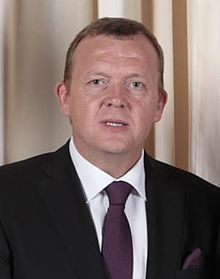Prime Minister of Denmark
| Minister of State of the Kingdom Denmark Danmarks statsminister |
|
|---|---|

Logo of the Ministry of State
|
|

|
|
| Style | Mr./Mrs. His Excellency (diplomatic, outside Denmark) |
| Member of |
Council of State Cabinet European Council |
| Residence | Marienborg |
| Seat | Christiansborg, Copenhagen, Denmark |
| Appointer | The Monarch Based on Appointee's ability to gain majority support in the Folketing |
| Term length | No fixed term, up to four years |
| Formation | 22 March 1848 |
| First holder | Adam Wilhelm Moltke |
| Deputy | Minister of Foreign Affairs |
| Salary | kr. 1,458,000 p.a. ($ 269,830) |
| Website | The Prime Minister's Office |
The Prime Minister of Denmark (Danish: Danmarks statsminister; literally "Minister of State") is the head of government in the Kingdom of Denmark. Before the creation of the modern office, Denmark did not initially have a head of government separate from its head of state, namely the Monarch, in whom the executive authority was vested. The Constitution of 1849 established a constitutional monarchy by limiting the powers of the Monarch and creating the office of premierminister. The inaugural holder of the office was Adam Wilhelm Moltke.
The Prime Minister presides over a cabinet that is formally appointed by the Monarch. In practice, the appointment of the Prime Minister is determined by their support in the Folketing (The National Parliament). Since the beginning of the 20th century no single party has held a majority in the Folketing, so the Prime Minister must head a coalition of political parties, as well as their own party. Additionally, only four coalition governments since World War II have enjoyed a majority in the Folketing, so the coalitions (and the Prime Minister) must also gain loose support from other minor parties.
The current Prime Minister of Denmark is Lars Løkke Rasmussen. He leads a government consisting of Venstre with parliamentary support from the Danish People's Party, Liberal Alliance and the Conservative People's Party.
From approximately 1699 to 1730, the highest ranking non-monarchial government official was titled the "Grand Chancellor" (storkansler) and from 1730 until 1848, this office was titled "Minister of State" (Statsminister). These titles foreshadowed the modern office of Prime Minister, however, unlike the current office, the Grand Chancellor and State Minister were not formal heads of government. The King held executive authority as absolute ruler from 1661 until the enactment of a liberal Constitution in the early nineteenth century.
...
Wikipedia

